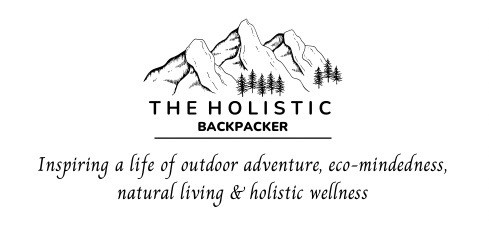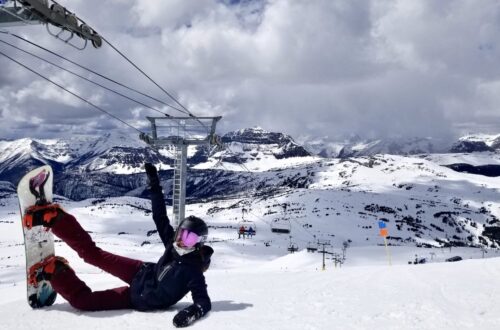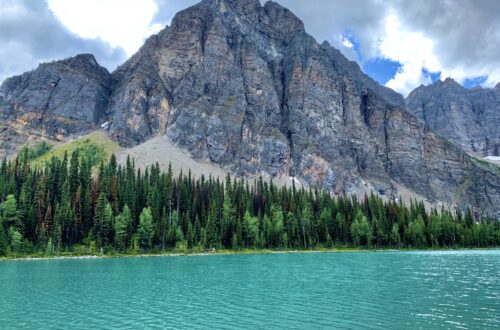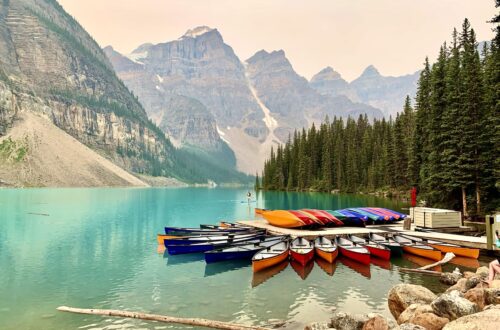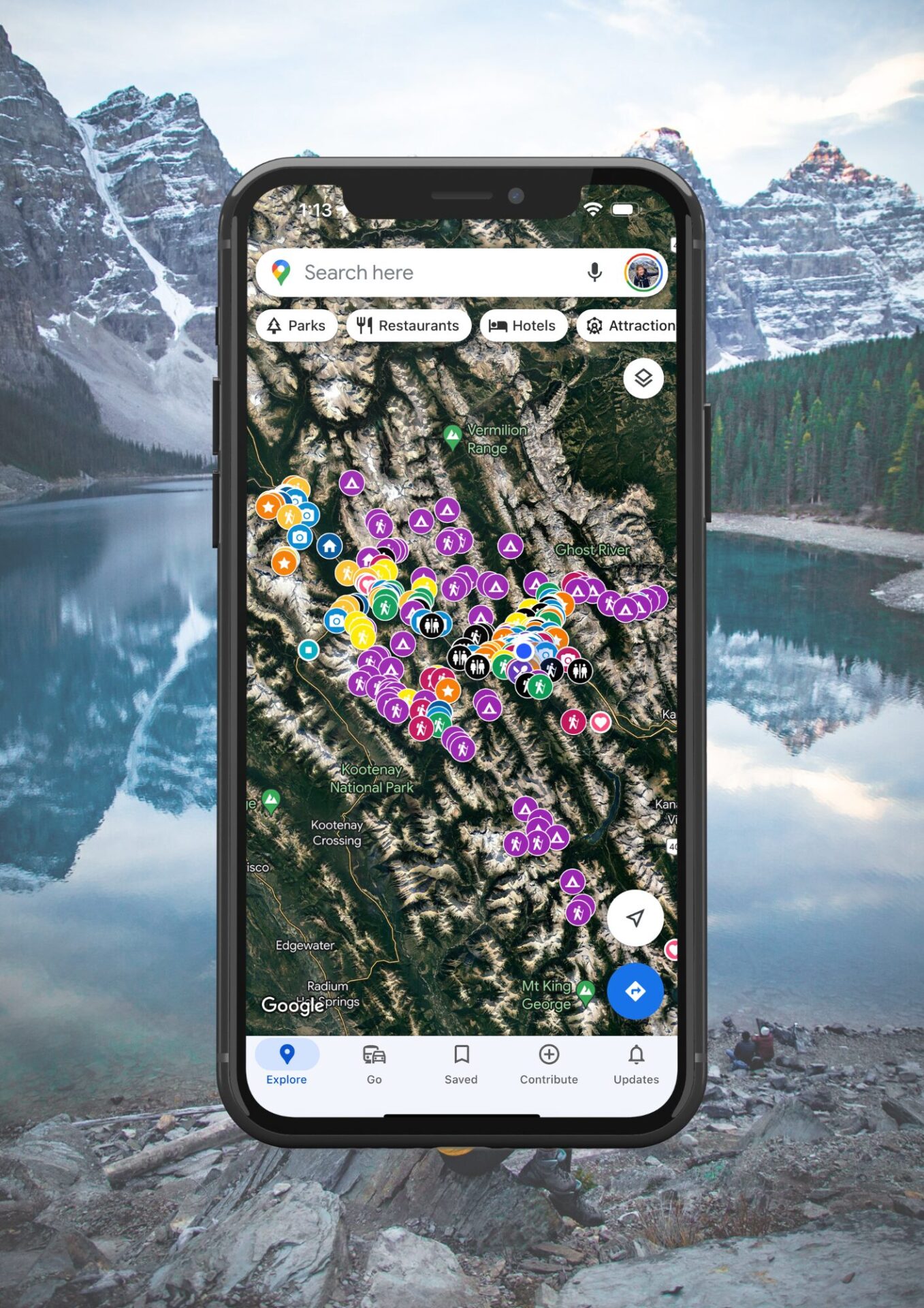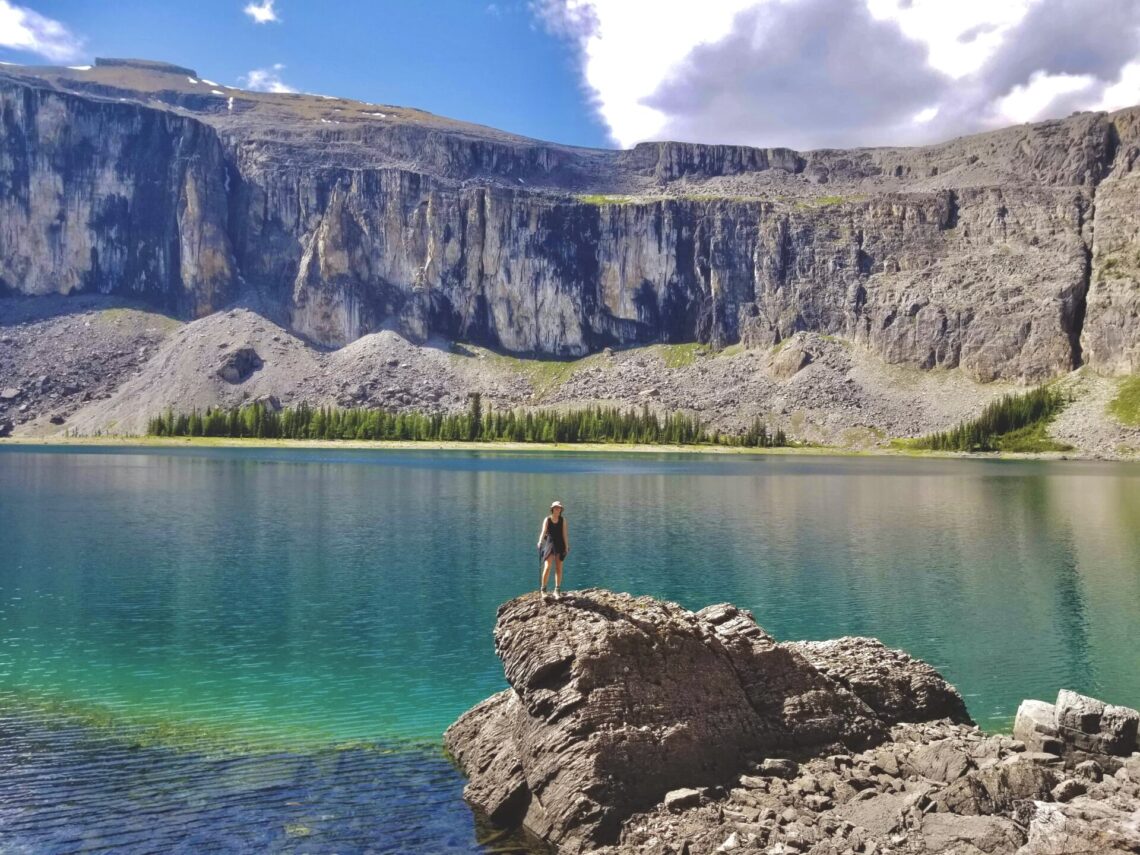
Hiking to Rockbound Lake Behind Castle Mountain – Banff
Did you know you can actually hike to a sparkling blue alpine lake nestled behind the famous Castle Mountain (formally known as Eisenhower Peak)? The Rockbound Lake trail is a long, but rewarding day-hike in Banff National Park that’s great for sightseeing and fishing; yup this trail is for anglers too!
The Rockbound Lake trailhead is located just down the road from Johnston Canyon. It features two lakes, a waterfall, and the opportunity to complete a massive summit.
Now, let’s go hiking!
Skip Ahead:
- How to get to Rockbound Lake trailhead
- About Rockbound Lake trail
- Hiking to Rockbound Lake
- Fishing at Rockbound Lake
- Essential gear for hiking
- What to wear hiking
- Best places to stay in Banff
As you read this post, please consider clicking the links throughout. These are affiliate links which means when you book a hotel or purchase a product, I make a small commission at no additional cost to you (full disclosure). These commissions fund The Holistic Backpacker and help me write more blog posts.
Thank you for supporting my work!
Related Content
- 50+ Things to do in Banff in summer
- Discover more Banff trail guides
- Complete guide to the Icefields Parkway
- Step-by-step guide for planning a trip to Banff
- What to wear hiking in Banff
- Hiking gear guide for Banff
How To Get To Rockbound Lake Trailhead
The Rockbound Lake trailhead is located about a 25 minute drive from the town of Banff on highway 1A. In previous years the 1A has been closed, in this case utilize the parking lot across from the Castle Mountain gas station. I’ve marked the Rockbound Lake trailhead and the alternate parking lot across from the gas station on this map.
Other options for getting to the trailhead include biking from town or taking the Roam bus to Johnston Canyon/biking from the drop off point.
Remember: Banff is a National Park which means you’ll need a Park’s pass for each day in the Park. You can buy these online, at the visitor centre, or at the Park gates when you enter Banff.
About Rockbound Lake Trail
- Distance: 17.9km
- Elevation gain: 1 021m
- Rated: moderate
- Type of trail: out & back
- Estimated time: 7hrs
Alternate Route – you can also summit Castle Mountain/Eisenhower Peak! This hike is not for the faint of heart, but it is a beauty. Here’s the Castle Mountain summit route on Alltrails and one hiker’s experience on the trail.
The Rockbound Lake hike is long and moderately trafficked trail that gains steady elevation.
This trail starts off in a wooded area where you’ll be following switchbacks up the mountain. Eventually the path emerges into a beautiful basin with incredible views of the backside of Castle Mountain. You’ll cross by Tower Lake, then arrive at the stunning Rockbound Lake.
Other Things To Know
Be warned, this trail is mad buggy! Thankfully it was windy the day I hiked detouring some of the pesky mosquitos, but some of my pals weren’t so lucky when they attempted this hike on a different day. I’d recommend taking a bug suit with you on this hike – it’ll literally save you!
Hiking in winter – it’s not recommended to snowshoe to Rockbound Lake in winter due to frequent avalanches. If you plan to hike the Rockbound Lake trail in winter, proceed only to Tower Lake unless you’re an experienced hiker, have avalanche training, avalanche gear, and have checked the avalanche bulletin.
More: Level 1 and level 2 avalanche training courses.
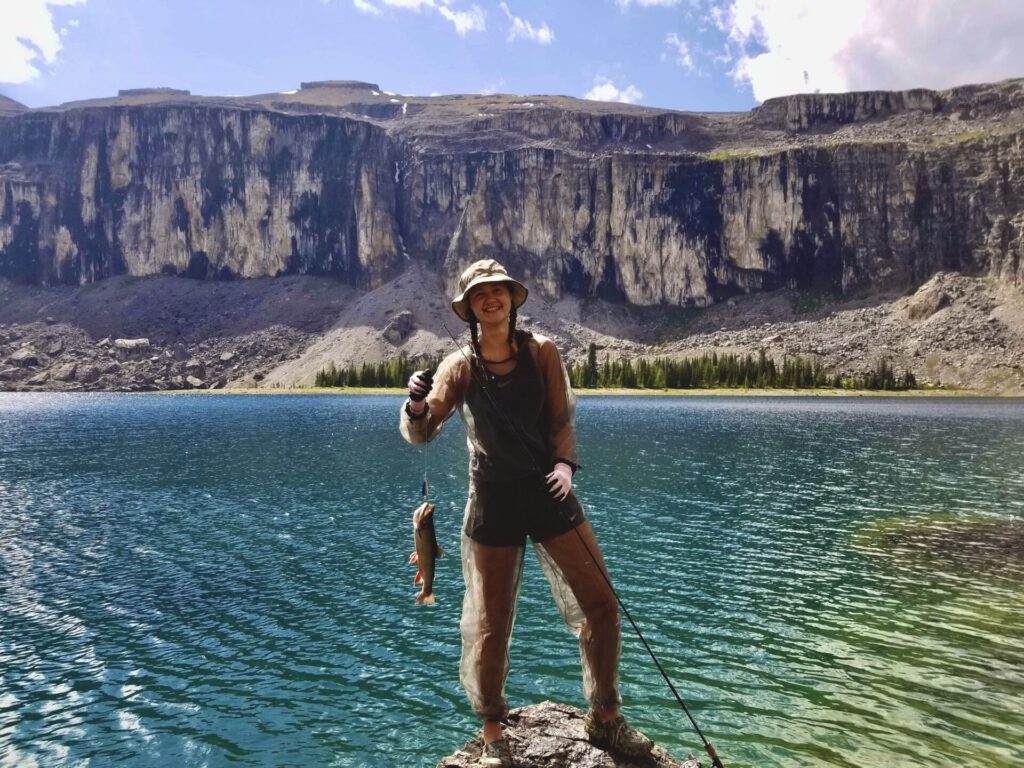
Hiking to Rockbound Lake
The Rockbound Lake trailhead leads directly into the forest where you’ll follow switchbacks up the mountain. This section of the hike is not scenic as you’re completely surrounded by trees, however it is quite peaceful and there are normally lots of grouse (AKA mountain chickens) running around!
Approximately 0.3km into the Rockbound Lake hike the trail will split; you can hike left for Rockbound Lake and right for Silverton Falls which is a 1km detour. Silverton Falls is a popular winter hike in Banff; you can explore my guide for winter in Banff here.
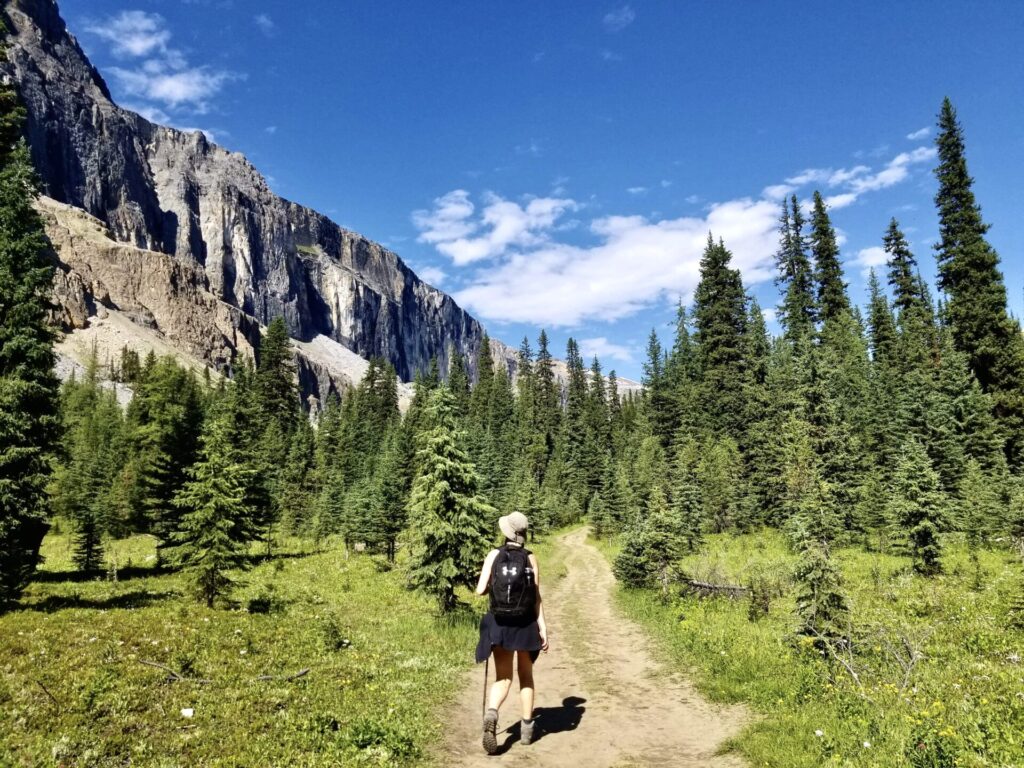
After making it up the switchbacks you’ll arrive at the basin in which the elevation will level out and you’ll have the chance to walk on flat ground surrounded by gorgeous mountains; the most striking being Castle Mountain (hiker’s left).
This is also a great hike if you’re on the hunt to find Rocky Mountain wildflowers. The best time of year to see wildflowers in Banff is in July, however it really depends on weather, the elevation of your hike, as well as a few other factors. Park’s Canada has a bit more information on this.
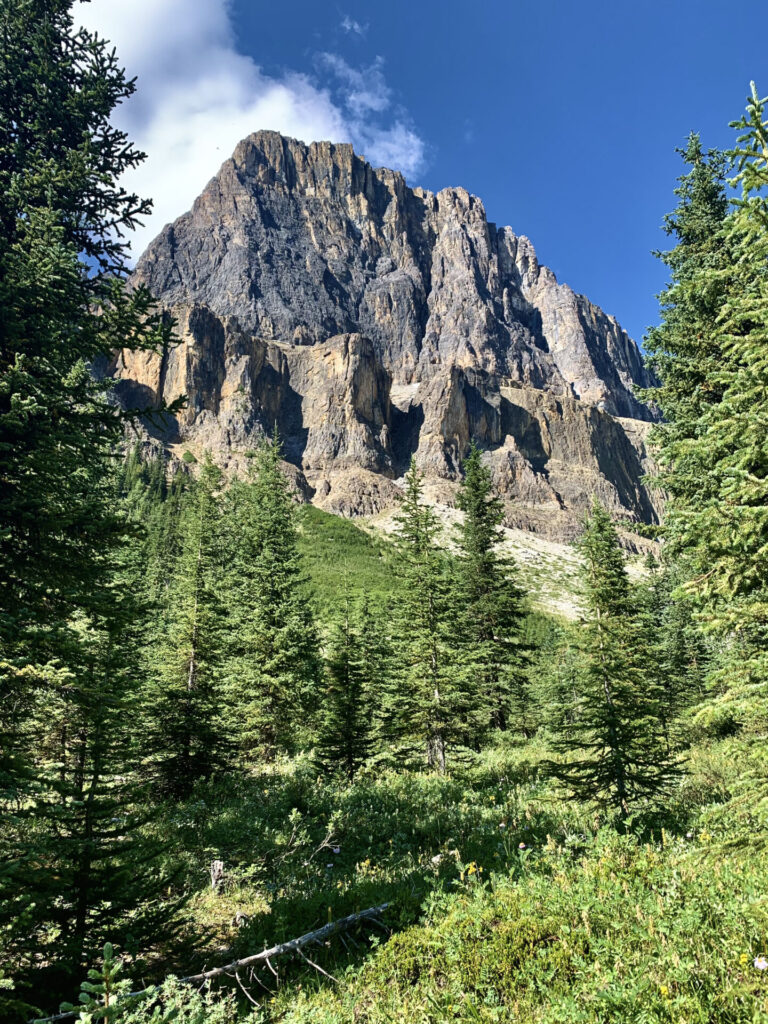
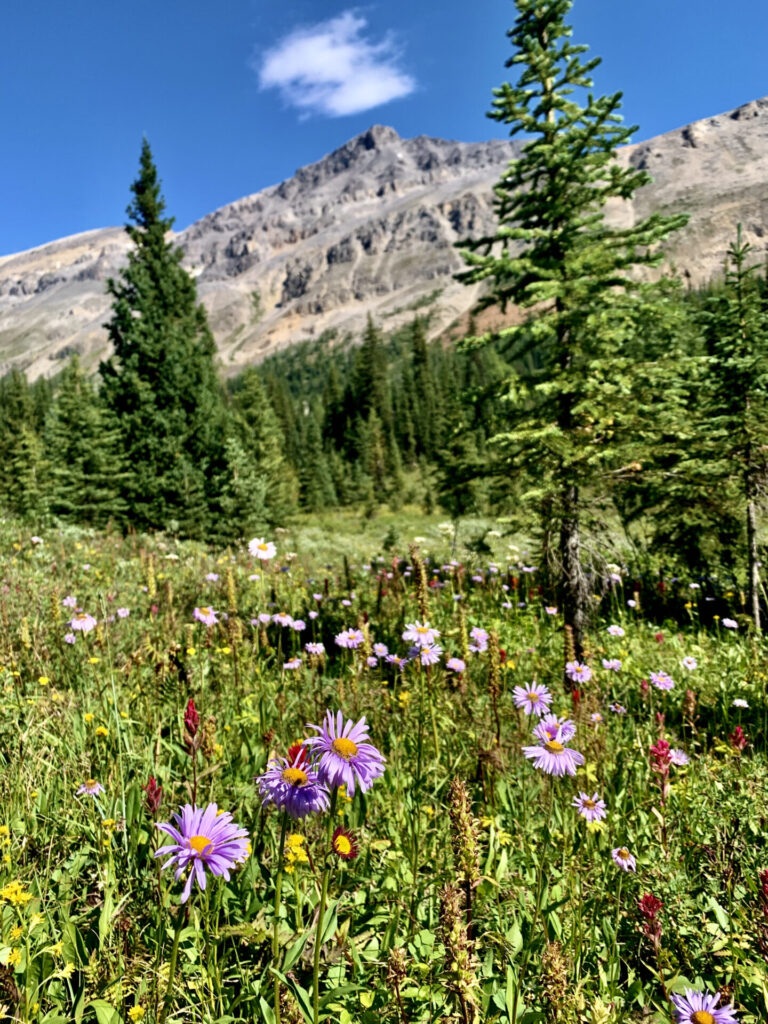
Tower Lake
You’ll cross a few streams and small bridges as you venture through the basin, then you’ll arrive at Tower Lake; the first lake on the Rockbound Lake hike.
This is a great place to take a quick breather, have some water, and grab a snack because the next section has a short-lived, but steep climb.
Next, hike around the right side of Tower Lake and follow the Rockbound Lake trail up and back into the trees. Along the way you’ll find Tower Lake Lookout which makes Tower Lake look even more WOW.
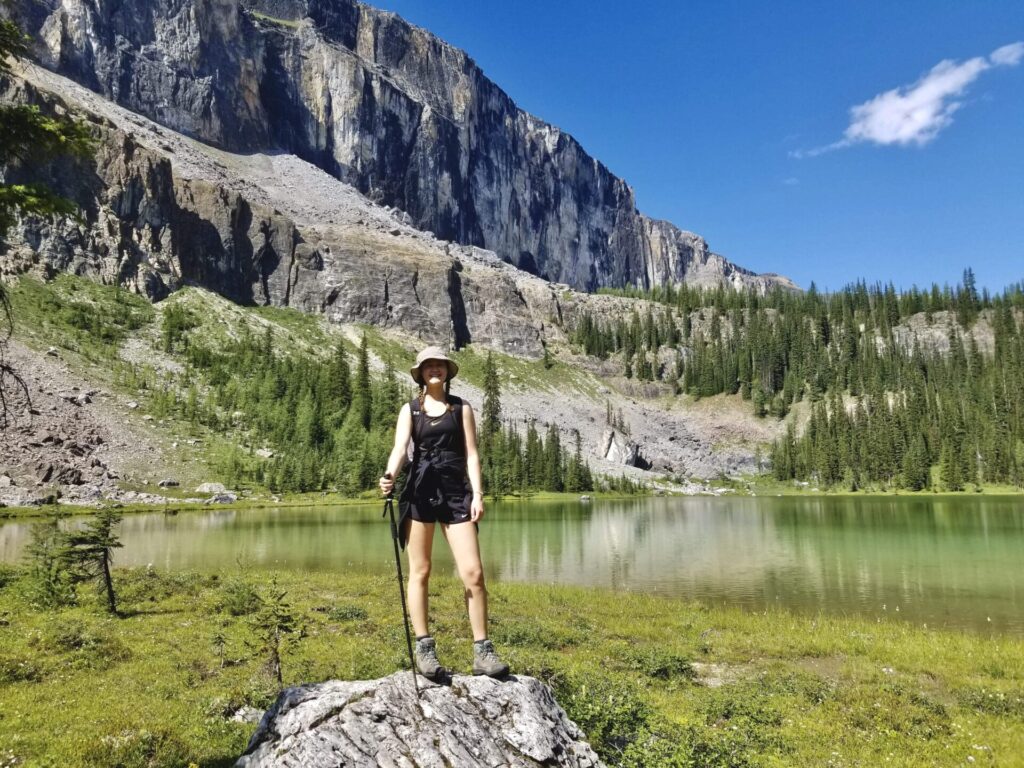
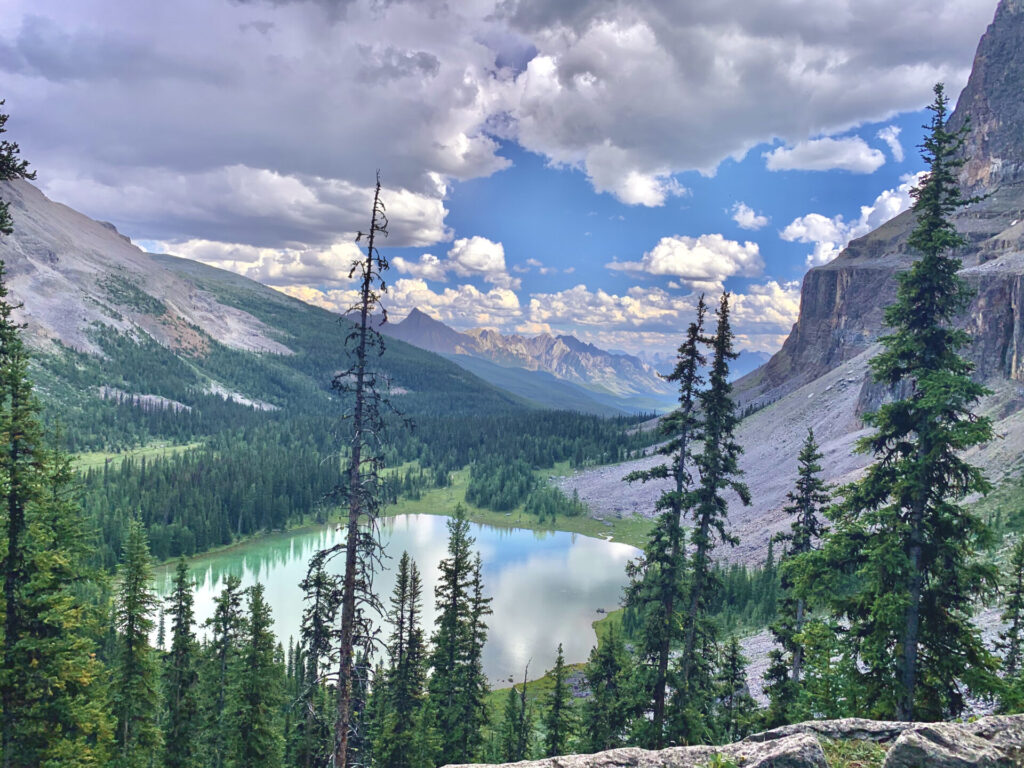
At this point you’ve pretty much made it to Rockbound Lake! Before you find the sparkly blue water of the lake though, you’ll have to navigate through some trees. You’ll notice paths leading in every direction here and it’ll seem confusing, but don’t stress. Every path will at some point bring you to the lake, so just keep hiking!
Rockbound Lake
Once you make it to the lake you can hike around the lake or complete the Castle Mountain summit. Myself and my friend Greg (the creator of Banff Buzz) hiked around the right side of the lake and went fishing – which I’ll talk more about next.
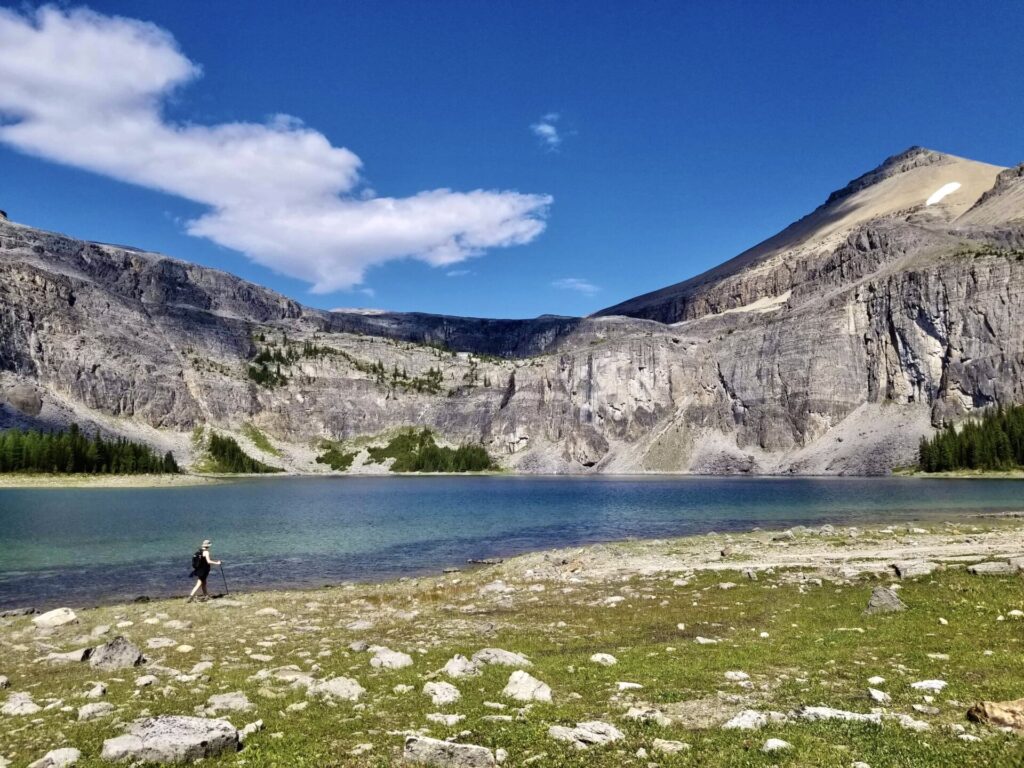
Next I’ll talk about fishing at Rockbound Lake, what to wear hiking in the Rockies, essential hiking gear, and cheap ways to visit Banff.
Looking for More Banff Adventures?
Banff is an adventurer’s & view seeker’s paradise. If you’re planning a trip to this gorgeous Canadian Park, you can start with this step-by-step guide designed to help you plan the perfect Banff itinerary.
Alternatively, check out this page with all my Banff resources.
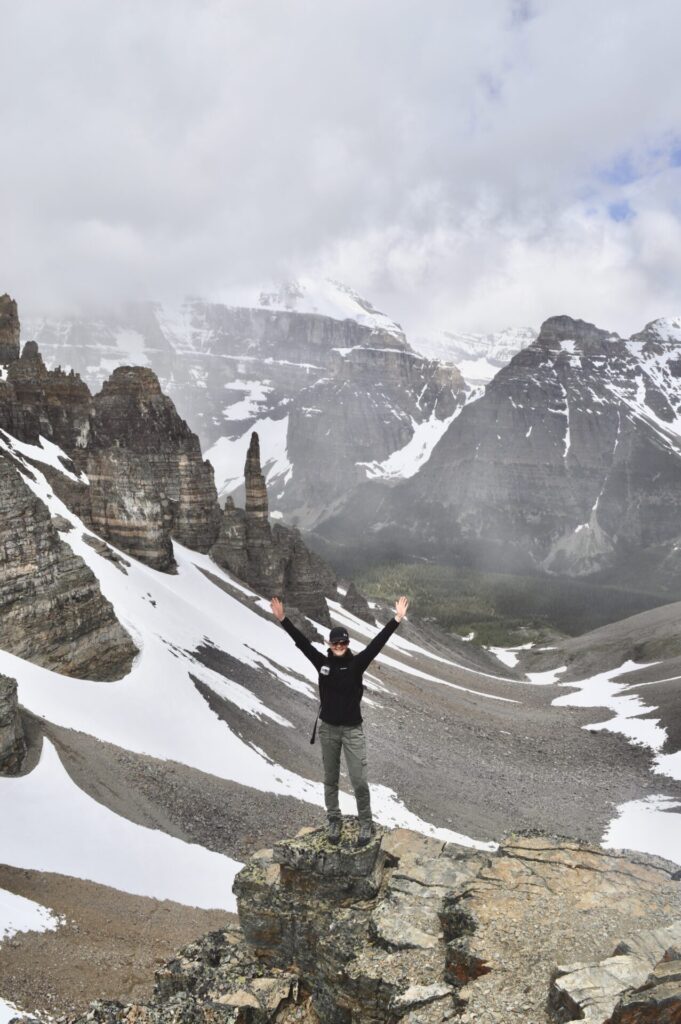
Banff Hiking Resources
On this page you can find all my Banff trail guides. A few signature hikes in Banff are these easy trails, Tunnel Mountain, Sulphur Mountain, Lake Louise, and Johnston Canyon. If you’re only in Banff for a few days, start with those!
A few of my personal favourite hikes in Banff are Mount Bourgeau, Sentinel Pass, Tower of Babel, the Banff Skoki Loop, and the Sulphur Mountain Traverse Route.
More Banff Resources you Might Find Interesting:
Want to continue your Canadian Rockies expedition outside of Banff? Check out my trail guides & travel resources for British Columbia and Kananaskis Country as well as Jasper, Waterton, Yoho, and Kootenay National Parks 🙂
Fishing at Rockbound Lake
Find the rules & regulations for fishing in Banff National Park HERE.
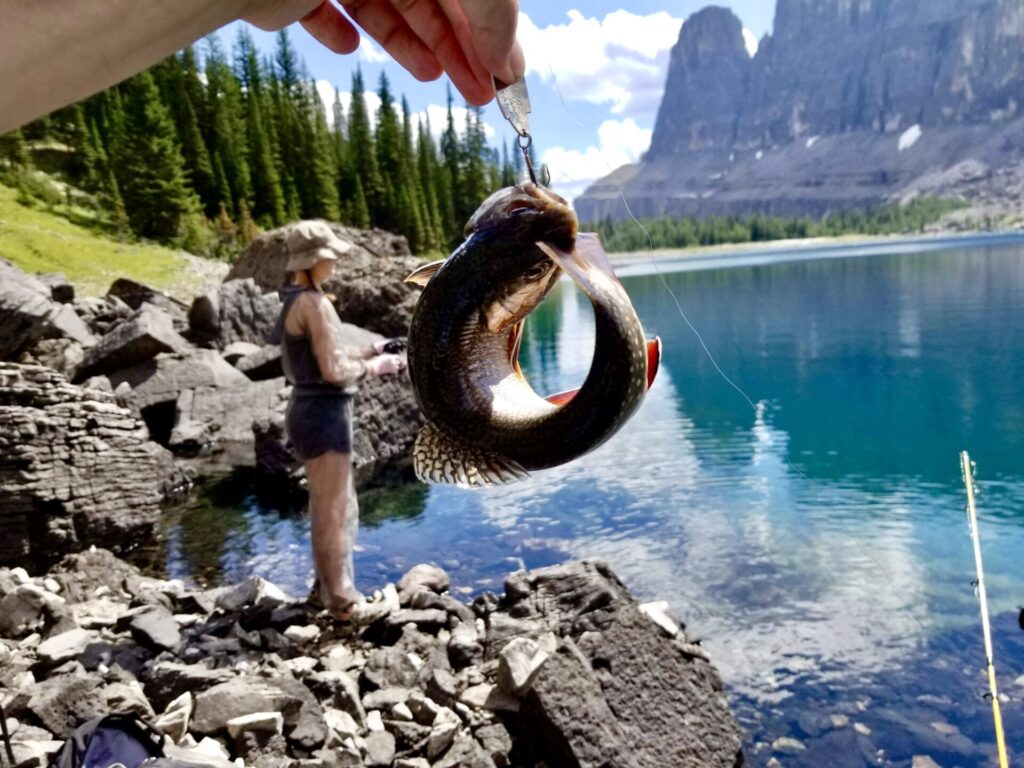
My friend Greg and I have a little tradition of going on one Rocky Mountain fishing trip each summer. This summer’s lucky pick was to go fishing at Rockbound Lake!
We packed lots of snacks and lots of fishing gear and quite frankly set up shop on the shore of Rockbound Lake. I’ve gone fishing a few times in Banff, but nothing quite compares to the fishing that Rockbound Lake offers!
We were seriously reeling in a rainbow trout for every cast – no exaggeration!
We fished for probably 2+ hours before the rain started and we had to leave. In that time I want to say we reeled in about 60 fish. Not big fish, but let’s be honest, you don’t catch anything big when you’re fishing in these high elevation alpine lakes.

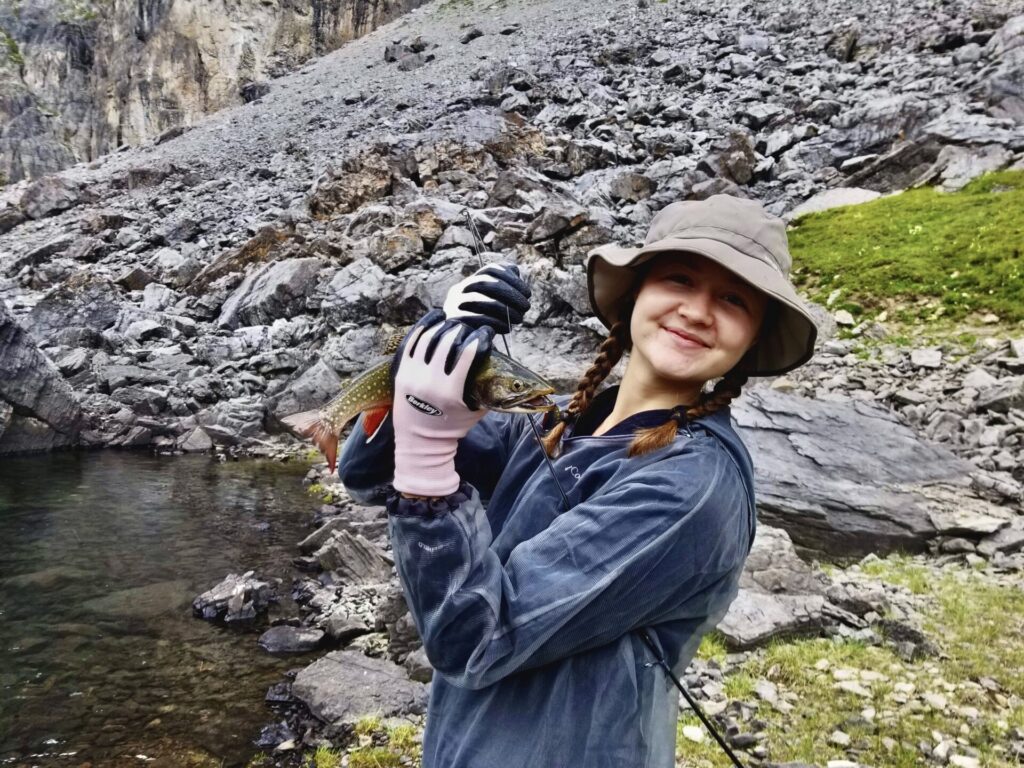
Something I’m so happy I brought with me when I went fishing at Rockbound Lake was my bug suit – if not I would’ve been eaten alive for sure.
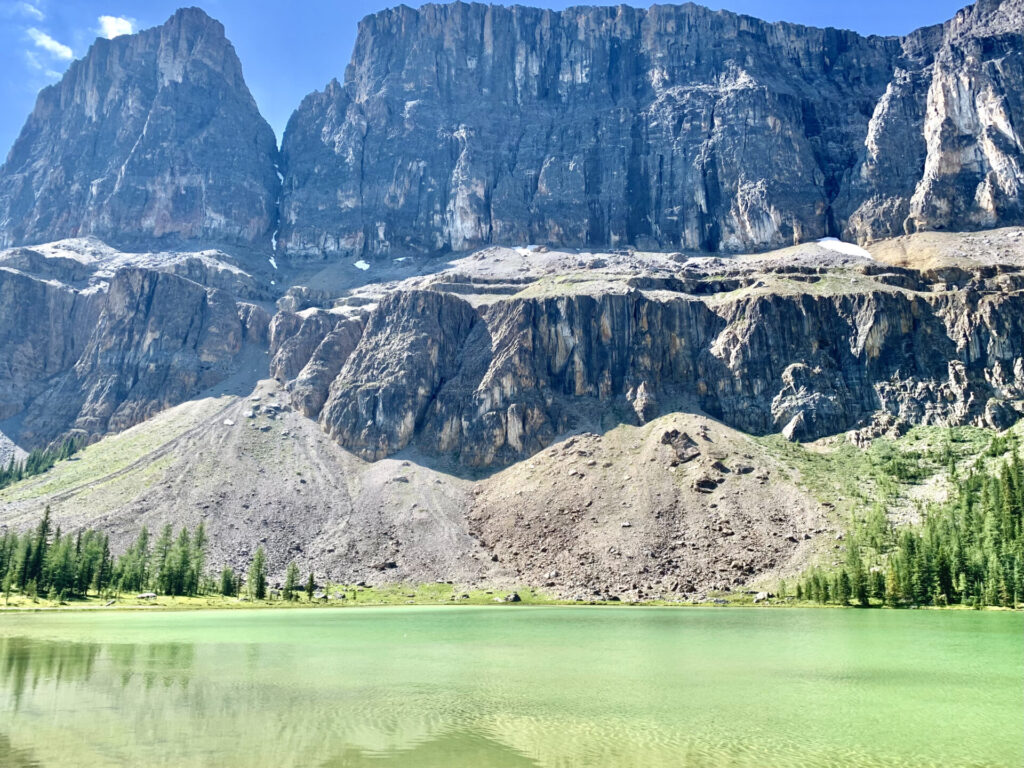
Rockbound Lake Takeaways
The Rockbound Lake trail is a great hike for anyone (as long as you have moderate fitness) that features beautiful lakes, stunning mountains, and good vibes.
One of my favourite things about this hike was watching the colour of Rockbound Lake change. As the sun appeared and disappeared, when the rain started, vs different times of day the water changed from bright blue, to turquoise, to light green.
Rockbound Lake is a MUST if you’re planning to hike in Banff!
Where to Stay in Banff
This post is my detailed breakdown of the best hotels in Banff – all organized by category.
Booking.com- Hostels – Samesun Banff (best location + bar/restaurant on-site), Banff International Hostel, and HI Banff.
- Budget stays – Bow View Lodge and High Country Inn.
- Mid-range stays – Banff Park Lodge, Mount Royal, Elk & Avenue, and the Banff Caribou & spa.
- Luxury stays – Fairmont Banff Springs and the Rimrock Resort.
- Camp – reservation information.
- See all Banff accommodations.
Travellers can also opt to stay in locations near Banff:
- Lake Louise – Fairmont Chateau Lake Louise (luxury), Paradise Lodge & Bungalows (500m from the lake), Lake Louise Inn (value stay), HI Lake Louise (hostel).
- Canmore – Malcolm Hotel (luxury), Stoneridge Mountain Resort (condo suites with fully equipped kitchens), Mountain View Inn (budget), Canmore Downtown Hostel & the Canmore Hostel (party hostel).
- Johnston Canyon – Johnston Canyon Lodge & Bungalows, Castle Mountain Chalets, and HI Castle Mountain Hostel.
- Yoho National Park – Emerald Lake Lodge and Cathedral Mountain Lodge.
- Kootenay National Park – Storm Mountain Lodge & Cabins.
- Kananaskis Country – Mount Engadine Lodge and Kananaskis Mountain Lodge (luxury), Crosswaters Resort (mid-range), and HI Kananaskis Wilderness Hostel (budget).
Happy adventuring!
Taylor ♡
Like This Post?
Share with friends or save it for later!
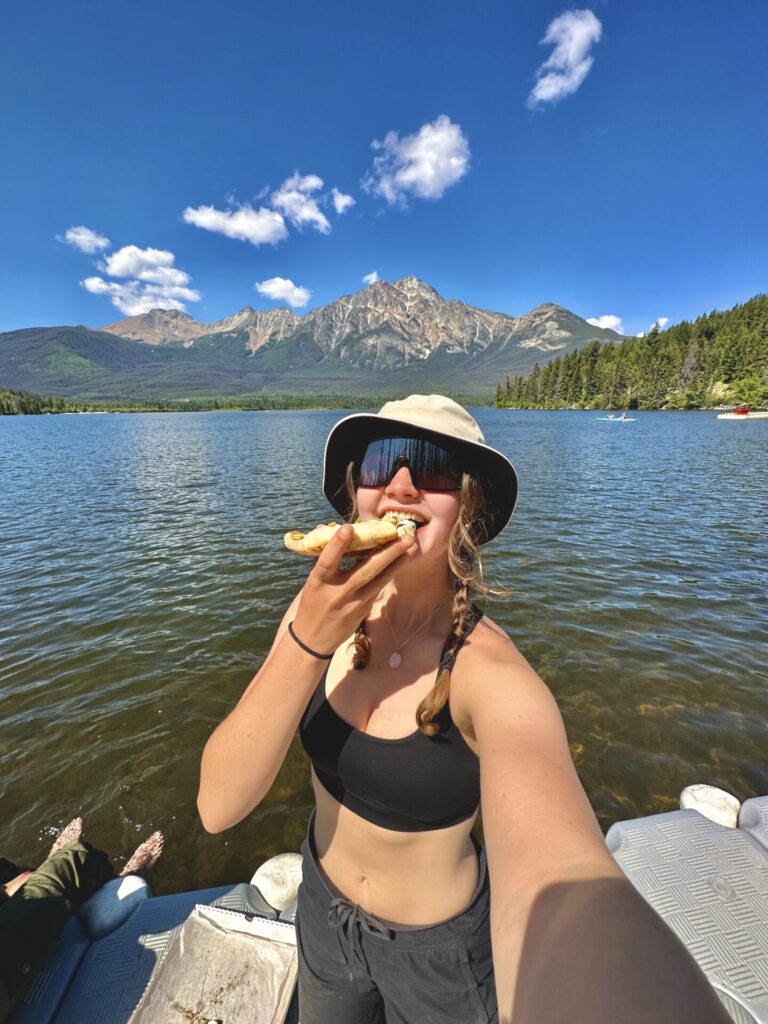
About The Author
HI, I’m Taylor – the voice behind The Holistic Backpacker.
After moving to Banff National Park in 2020 I became an outdoor adventure enthusiast and vowed to never stop exploring.
I now spend my days travelling the world, climbing mountains, and spending nights under the stars in the Canadian Rockies backcountry.
I created The Holistic Backpacker so I could share my adventures and help connect people like you with the same amazing experiences.


